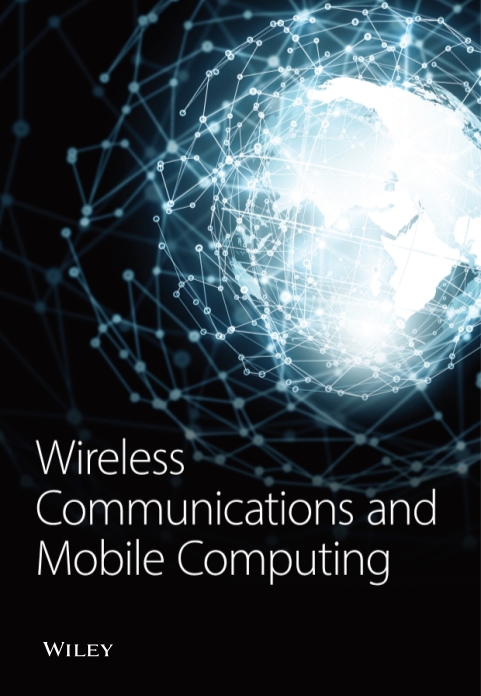RETRACTED: Course Teaching Design and Practice Analysis by Intelligent Electronic Technology under Big Data
Abstract
The exploration expects to improve the teaching quality of the electronic technology distance course. The teaching management system of the electronic technology network course is constructed based on a flipped classroom. Firstly, the idea of the flipped classroom is analyzed, and the electronic technology course is designed. Secondly, the teaching management system of the electronic technology network course is established, and the remote experiment module is discussed. Finally, the questionnaire survey is made to investigate the use effect of the system. The results show that about 79% of the students are satisfied with the system. About 80% think it allows them to focus on the teaching process. Only 1.3% think that this system does not work for their learning. This shows that the system can help students improve their learning efficiency. However, the main defect is the lack of a real-time feedback module for users on the application effect of the system. In a word, the exploration provides a reference for developing and designing the follow-up network course teaching system.
1. Introduction
With the advent of big data, network technology, electronic information technology, and internet technology have rapidly developed [1]. The advantage of network technology and information technology is that they can speed up the efficiency of information transmission. However, some defects are unavoidable, mainly because the development of network technology makes personal privacy data often stolen by network hackers. At present, the internet-based network teaching model has become an indispensable learning tool for young people [2]. The emergence of the online teaching mode breaks the limitations of time and space [3] and provides the primary condition for scholars to explore more independent and effective learning modes. Recently, the research of network teaching modes has achieved remarkable results. However, there are also some defects in network teaching that teachers and students in network teaching cannot have direct contact, and teachers cannot grasp the learning effect of students.
Aydin and Dinc took 63 neglected students as the research subjects, collected data from the demographic information, and tested their arithmetic skills and drug dose calculation skills to explore the effect of the online teaching system. The results show that the network teaching system improves students’ ability to calculate drug doses [4]. Dogru studied the cognition of preservice visual art teachers on computer self-efficacy and their attitude towards online teaching and learning. They selected 250 preservice teachers as the research subjects. They took gender, class, and academic success as variables to compare students’ cognition of computer self-efficacy and their attitude towards online teaching. The results show that preservice visual art teachers had higher computer self-efficacy and good attitudes towards online education [5]. Odewumi discussed the impact of online teaching packages on the academic performance of visual art learners in Nigeria’s high schools. It is found that visual art learners perform better, and there is no significant difference in the average score between male and female visual art learners who receive online teaching [6]. Lucas explored the relationship between explicit instruction and computer-assisted language learning to reduce plural marking errors for Japanese English learners. He investigated whether online education can promote the accuracy of plural marking. The results show that online teaching has achieved good error recognition and plural marking [7]. Elmabaredy et al. used multimedia and framework technology to teach students knowledge and compared the students’ learning effects. The results show that network-based adaptive demonstration technology positively impacts students’ learning effects [8].
At present, the research on online teaching is mainly about the theory and art courses, and the research on practical courses is less. Based on the teaching mode of flipped classrooms, the teaching management system of electronic technology network courses is established, and the remote experiment module is discussed. Then, the use effect of the system is investigated by a questionnaire survey. The innovation lies in the combination of remote experiments and network teaching modes, and the network teaching management system of electronic technology courses is designed. The research result provides a reference for other experimental courses’ network teaching and has practical significance.
2. Network Teaching System of Electronic Technology Courses
2.1. Flipped Classrooms
The flipped classroom is a new teaching mode [9]. In 2007, Jonathan Bergmann and Aaron Sams, chemistry teachers of Woodland Park High School in Colorado, USA, used video software to record PPT with verbal explanation and then uploaded the video they recorded to the network for the absent student, which forms the preliminary model of flipped classrooms [10]. At the symposium on flipped classrooms held in Colorado in 2011, the meaning of the flipped classroom is expounded [11], considering that the flipped classroom is student-oriented and can realize personalized education for different students. It improves students’ learning efficiency and determines students’ dominant position, enhances the interaction between students and teachers, and transmits knowledge through information technology, providing a relaxing and convenient teaching atmosphere. Flipped classrooms break the limitation of the traditional classroom teaching mode, make students learn more autonomously and freely, and give teachers more freedom to arrange teaching activities, fully respecting students’ individuality. Thus, students can plan their learning progress according to their learning ability and provide more opportunities for them with expertise. Figure 1 presents the advantages of the flipped classroom mode. The most important learning mode is the flipped classroom, which can help students break through the limitations of time and space through effective learning interaction, thereby providing more opportunities for students to expand their professional knowledge.
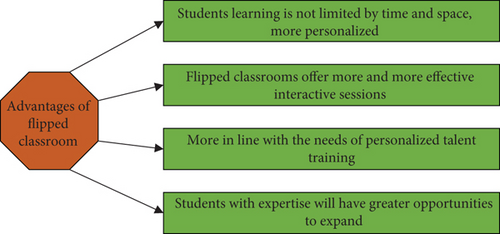
2.2. Design of Electronic Technology Network Course Based on Flipped Classrooms
According to the teaching content, curriculum design is the learning plan [12]. The main content of electronic technology is electronic devices and circuits. Therefore, the teaching objective of the course is to make students know about the semiconductor components of electronic circuits, their basic concepts and principles, and their basic analysis methods. Electronic technology is widely used and practical. In daily life, electronic watches, computers, televisions, radios, mobile phones, and much other electronic equipment are made by electronic technology. Electronic technology is a course that needs a significant number of experiments. It is impossible to solve practical problems only by theoretical learning in learning electronic technology. A standard method for solving practical problems is to simplify the main contradictions by using approximate methods and then adjust the results in the experiment based on qualitative and quantitative analyses.
Based on the characteristics of theories and experiments of electronic technology, it is found that the teaching mode of flipped classrooms can fit electronic technology teaching. The teaching mode of electronic technology network courses based on the flipped classroom is designed and divided into three stages: preclass, in-class, and after-class.
In the preclass stage, students can preview the course with the preclass learning materials provided by the teacher, complete the preclass test questions, and communicate with the teacher on the problems. The teacher summarizes the results of students’ preclass tests and students’ questions and finds out students’ problem points. The teaching mode in the preclass stage is shown in Figure 2.

In the in-class stage, the teacher asks students questions or gives them topics, and the students are grouped to discuss them. When they have problems in the discussion, they can consult the teacher. Then, the discussion results are presented group by group, and other group members raise questions. The members in the group designated by the teacher answer the questions, solving the questions in the learning process. After that, the teacher asks additional questions that the students do not notice. Subsequently, the teacher summarizes students’ questions and answers the questions symmetrically. Finally, other students, the teacher, and the test scores evaluate students’ performance. The teaching mode of the in-class stage is shown in Figure 3.

The teacher sends the after-class experiment in the after-class stage, and the students carry out the remote investigation in groups. If there are some questions in the experiment, they will be answered by the teacher or other students.
2.3. Design of the Remote Network Teaching System of Electronic Technology Courses
According to the design of the experiment of electronic technology courses, the network teaching system of electronic technology courses is set 5 functional modules, namely, the system management module, curriculum management module, teaching management module, remote experiment management module, and evaluation management module.
The system management module falls into user management and data management. User management functions are user query, user deletion, user modification, and user increase. The users include students, teachers, and administrators. The primary function of data management is to backup and restore data. The structure of the system management module is shown in Figure 4.

The course management module is uploaded and updated by the teacher in time.
The teaching management module has homework, tests, discussion, and question-answering. Homework and test management is for teachers to send homework and test questions, and then, students submit the completed task and their answers to the questions. Students or teachers can ask questions or provide topics for discussion by a post in the discussion and question-answering. Other students and teachers can participate in the debate and answer the questions.
The remote experiment management module is mainly for students to apply for remote experiments, complete remote investigations, and submit the experimental results.
The evaluation management module includes all students’ test scores, classroom performance scores, and total scores.
The function of the system is designed, as shown in Figure 5.
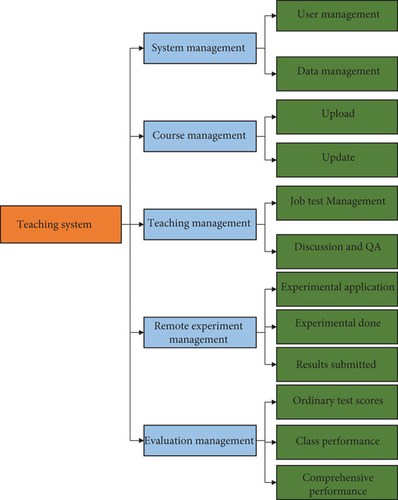
MySQL is chosen as the system database because it is flexible and easy to use and can meet the requirements of the system design. The system database is designed according to the relationship between users and entities. The MySQL (Structured Query Language) expansion is aimed at designing and developing software that allows PHP (Personal Home Page) applications. MySQL distributes tasks to multiple computers for replication, splitting, and data fragmentation by outward expansion. For the expansion of the IO (Input and Output) port of a single-chip microcomputer, the mode of the serial-to-parallel chip is adopted. Figure 6 discusses the relationship between students and entities and the database design.
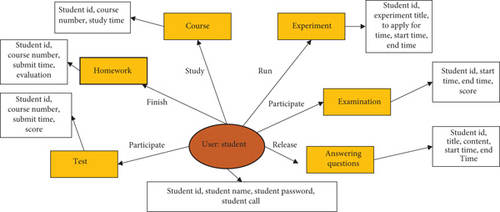
2.4. Design of the Remote Experiment Module for Electronic Technology Courses
Network-based experiments have virtual experiments [13] and remote experiments [14]. In network-based virtual experiments, the problems are solved by ignoring secondary contradictions and seizing the main contradictions. What is obtained through virtual experiments are ideal models and data so that students cannot visually observe experimental equipment and cooperate with other students. Through the remote experiment, students can complete the investigation through cooperation. They can visually see the actual experimental equipment and obtain accurate empirical data to understand electronic devices better and motivate students’ learning enthusiasm. The remote experiment module of the electronic technology course comprises three parts: client, server, and physical experiment equipment. Its structure is shown in Figure 7.
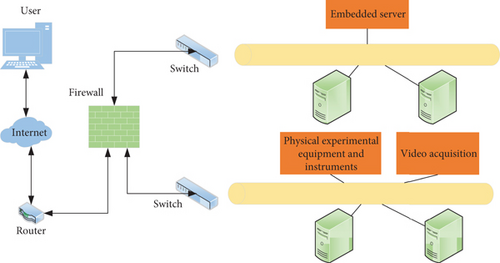
The user enters the remote experiment management module to apply for experiments by logging in to the remote teaching system and controls the virtual experiment instrument. The embedded server receives [15] the practical application, maintains the physical device according to the user’s virtual helpful device, and completes the experiment. The real-time experimental process is provided for the user through the camera. Finally, the experimental data and experimental results are transmitted to the user. There are a variety of controllable practical devices in the physical experimental terminal, and the testing process is completed by receiving control instructions.
The design of the remote experiment module includes three parts, namely, the design of virtual instrument hardware, virtual instrument software, and embedded server.
The hardware system of the virtual instrument is composed of the field programmable gate array subsystem [16], analog-to-digital converter subsystem [17], digital-to-analog converter system, and power supply. The embedded Web server adopts Lighttpd (name of server architecture mode). Its CPU (Central Processing Unit) has low occupancy and good efficiency. The hardware structure is displayed in Figure 8. FOA (field programmable gate array) represents the upper system of digital-to-analog conversion.
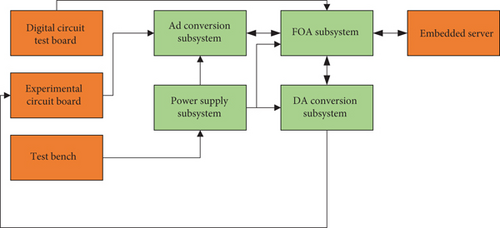
The function of FPGA is to collect, process, and transmit data, which is the core of the hardware system of virtual instruments. The AD conversion subsystem is the primary source of the data of virtual instruments, and it is responsible for the conversion of signals. The signals input by the outside world are analog signals, which are converted into digital signals through the AD conversion subsystem. The DA conversion subsystem can convert the signal source into waveforms, and the power subsystem provides suitable power for each system.
The virtual instrument software system comprises the Double Data Rate 3 (DDR3) control module [18], virtual oscilloscope module [19], virtual signal source module [20], and virtual logic analysis module.
In the DDR3 control module, the DDR3 interface controller is designed based on the Memory Control Block (MCB). The controller interface takes MCB as the core and is assisted by relevant FPGA resources.
In the virtual oscilloscope module, FPGA collects the data transmitted by an AD converter, stores the data into Random Access Memory (RAM) [21], and finally sends the data to the server through IO.
The server generates waveform data in the virtual signal source module and transmits them to FPGA through IO. The waveform data are sent in the form of 8 bits. Therefore, each two-bit datum corresponds to a DA input datum, and the two-bit data are stored in different RAMs, so that two RAMs work at one time. Before entering DA, the two-bit data can be combined into a DA input datum.
In the virtual logic analyzer module, the 64 sampling channels of the logic analyzer are connected with 64 pins on the digital experimental circuit board used to observe the logic state. The module is divided into five submodules: the clock network, high-speed RAM memory, RAM reading control, RAM writing control, and control module.
The embedded server is the core part of the remote experiment. Its main functions include controlling the camera to complete video acquisition, encoding and transmitting the collected videos, using virtual experimental instruments, and managing actual practical devices. Here, the embedded server uses the dual-core Intel Core Duo T2300 processor for core operation. The USB video acquisition card is for video acquisition, the H. 264 efficient video coder is for video coding, and the dynamic network bandwidth adaptation technology is for video transmission.
2.5. Practice of Electronic Technology Courses
Triode is the essential component in the electronic circuit. Through the “triode amplifier circuit,” students can analyze the amplifier’s performance through estimation, installation, and debugging of the low-frequency voltage amplifier circuit of single-stage transistors. And then, the use methods of the double integrated oscilloscope, function generator, AC millivolt meter, and DC regulated power supply are explored. Students are required to complete the measurement of working current, transistor voltage drop, voltage gain, input resistance, and output resistance in the experiment. The frequency sweeper observes the amplitude-frequency and phase-frequency characteristics of the circuit.
First, in the preclass stage, the teacher provides students with the learning materials of the transistor amplifier circuit, which can help the students be familiar with the concept of the transistor, the basic composition of the transistor amplifier circuit, and the basic principle to enable students to learn independently in advance.
Then, in the classroom, the new lesson is introduced through a brief description of the preview data. The triode is a semiconductor component that controls the current. Its role is to amplify the weak signal into a large amplitude of an electrical signal. According to the material, it can be divided into the germanium tube and silicon tube. According to the structure, it includes PNP and NPN.
The amplifier circuit is composed of the input signal source, semiconductor device, and output load. During the use of transistor amplification circuit, the voltage of transistor base is composed of two parts, one is direct current working voltage and the other is alternating current small signal input voltage. The use specification of the amplification circuit is that the oscilloscope is connected to the output end of the amplification circuit. It observes the output waveform by changing the amplitude of the input signal, as shown in Figure 9. Among them, the type of input signal source is the voltage value from -13.8 V to +13 V, and the type of output signal is the low output voltage value of -13.8 V. The semiconductor specification adopts the standard device with the symbol GB 1.1-2009, the input current is 50 mA, and the output current is 10 mA. Table 1 presents the main electrical characteristics.
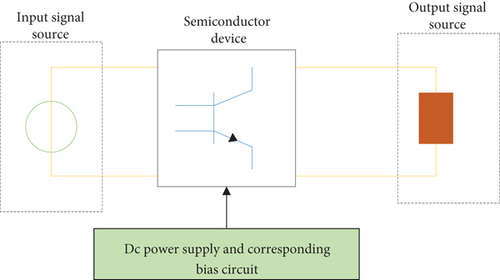
| V (V) | Mrr (dB) | Srr (dB) | Sr (s) | Bw (Mhz) |
|---|---|---|---|---|
| 15 | 60 | 70 | 2500 | 1200 |
The transistor amplifier circuit has three forms: the common-emitter, common-base, and common-set amplifier. The working states of the primary amplifier circuit are the static and dynamic states. The appropriate static working point is set in the amplifier circuit to make the circuit signal stable.
Group discussion is employed to conduct the simulation experiments of the three kinds of transistor amplifier circuits, the static analysis, and dynamic analysis, respectively, and the students’ difficult points are solved. Finally, the students show the simulation results.
After class, the teacher arranges the remote experiment of the transistor amplifier circuit, and students apply for the experiment online. The investigation is made in groups, and their knowledge is strengthened.
2.6. Survey of System Performance
The system designed is applied to teaching processes of electricity majors, involving electronic technology, and electronic science and technology of Xi’an University of Technology in Shaanxi. After three months, a questionnaire survey is conducted on the students to understand the application effect of the system.
The questionnaire’s content includes three dimensions: students’ satisfaction with the system, the effect of using the system in class, and the auxiliary effect of using the system in learning. Students’ satisfaction with the system is evaluated in five levels: totally satisfied, satisfied, neutral, dissatisfied, and totally dissatisfied. The effect of using the system in class is evaluated in five grades: completely concentrated, concentrated, neutral, deconcentrated, and completely deconcentrated. The auxiliary effect of using the system is also judged by five levels: very helpful, helpful, general, unhelpful, and completely unhelpful.
232 questionnaires are distributed, and 217 valid questionnaires are collected. The effective rate is 93.53%.
3. Results
3.1. Reliability Analysis of the Questionnaire
The Cronbach α coefficient is utilized to effectively evaluate the reliability of the questionnaire. The results are shown in Table 2.
| Dimension | α |
|---|---|
| Students’ satisfaction with the system | 0.8923 |
| The effect of using the system in class | 0.9012 |
| Whether the use of the system is helpful to network learning | 0.9003 |
| Overall | 0.9023 |
Table 1 shows that α values of each dimension of the questionnaire are all above 0.8, meeting the reliability requirements. α values of the two dimensions of the effect of using the system in class and whether the system is helpful to online learning are 0.9012 and 0.903, respectively, indicating that the questionnaire is reliable. The overall α value of the questionnaire is 0.9023, meaning that the questionnaire is suitable for the research.
3.2. Result Analysis of the Questionnaire Survey
The transistor amplifier circuit is used to build the internal circuit of the proposed system, and the MySQL database is applied to implement the system data model. Students’ satisfaction with the system is evaluated from the levels of quite satisfied, satisfied, general, dissatisfied, and quite dissatisfied, as Figure 10.
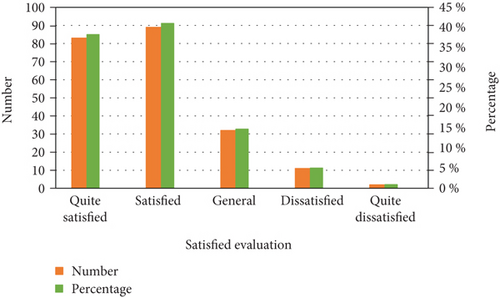
Figure 10 shows that about 79% of the students are totally satisfied with the system, and 41% are satisfied with it. The overall satisfaction reaches 79%. 5% are dissatisfied with it, and 0.9% are completely dissatisfied. The total dissatisfaction is only 5.9%. This indicates that the system is relatively satisfactory for most students.
The system’s results are statistically analyzed, as shown in Figure 11.
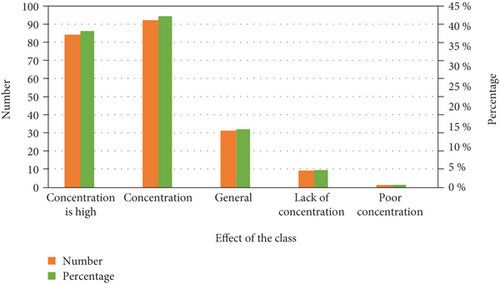
Figure 11 shows that about 38% of the students think that their attention is very concentrated when using the system in class; 42% believe their attention becomes more concentrated. About 0.4% of the students argue that their attention is distracted, and about 0.04% mention that their attention is completely distracted. Generally, 80% of the students feel that using this system in class can make their attention focused, indicating that the system constructed can help most students improve their learning efficiency.
The accuracy of the statistical results of the system is evaluated, and the results are shown in Figure 12.
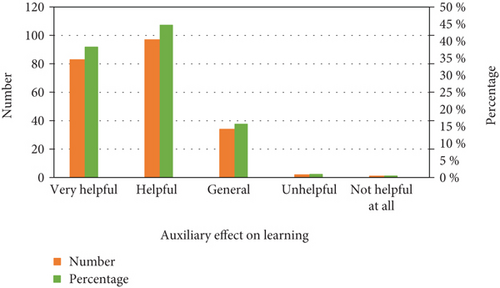
Figure 12 shows that the statistical accuracy of the system reaches 45%, and the performance evaluation score is close to 40%. In general, 1.3% of students hold that the system is not helpful, and 80% think that the system is very helpful for course teaching, indicating that the system helps most students learn the knowledge of electronic technology courses in class.
4. Conclusion
With the development of science and technology, human educational concepts and learning methods are constantly changing. Here, a network teaching mode of electronic technology courses is designed based on the flipped classroom, and then, the network teaching system of electronic technology courses is constructed. Then, the remote experiment module is designed according to the characteristics of electronic technology courses. Finally, the use effect of the system is investigated by a questionnaire survey. And the reliability of the questionnaire is analyzed. The results show that the reliability of each dimension is above 0.8, and the overall reliability is above 0.9. They meet the requirements of the survey. The survey results show that about 38% of the students are totally satisfied with the system, and 41% are satisfied. Generally, only 5.9% of the students are dissatisfied with the system. 80% of the students think that their attention can be focused when using the system, while only 0.44% argue that their attention is distracted. Besides, 80% of students believe that the system is helpful. However, 13% think that the system does not work on their study, indicating that it can effectively help most students take the electronic technology course. There are still some shortcomings. For example, there is a lack of a real-time feedback module for users’ application effect on the system. In the follow-up study, the system’s function will be further improved.
Conflicts of Interest
The author has no conflicts of interest, financial or otherwise.
Acknowledgments
This work was supported by the Jilin Province Higher Education Research Fund “Research on the Construction of Labor Education Security System in Higher Education Institutions” (JGJX2021D393).
Open Research
Data Availability
All data are available from the corresponding author upon request.



